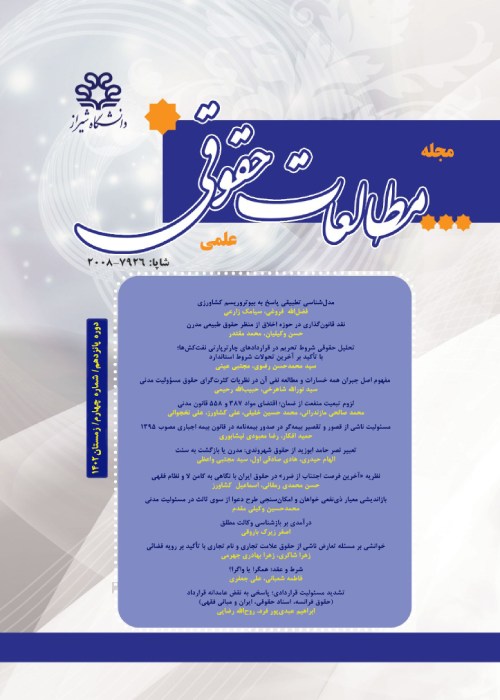An Analysis of the Legal Concept of "Genetic Resources" in the Light of International Documents and Iran's Legal System
The legal concept of "genetic resources" is a subject of central importance, casting its influence over various domains of genetics, including the utilization of genetic resources, the benefits derived from them, legal frameworks governing access and benefit sharing of genetic resources, and the obligations of involved parties. However, despite its critical role, the definition and interpretation of genetic resources remain enigmatic. The understanding of governments and legislatures concerning genetic resources holds profound implications for the development of legal articles and systems regulating access and benefit sharing. Any interpretation of this concept resonates within the legal framework, leaving discernible impacts on the mentioned domains. The nature of interpretation regarding genetic resources holds the power to either expand or restrict the scope of legal systems governing access and benefit sharing. A narrow interpretation of genetic resources limits the reach and subject matter of the legal framework, whereas a broader interpretation leads to its expansion and the inclusion of obligations within the access system. In a narrow interpretation, access to many genetic resources carries no legal obligation to share the benefits arising from them and their derivatives. Conversely, a broad interpretation subjects access to any genetic resource, its derivatives, and products to a legal obligation for benefit sharing. Within a narrow interpretation, products and derivatives derived from genetic sources fall outside the scope of legal obligations for benefit sharing. In contrast, a broad interpretation challenges the legal status of these derivatives and products, even when removed from their original source. The legal framework for sharing profits from future products and derivatives originating from genetic resources poses questions about the legal forms of profit sharing. Can future sales, fluctuating pricing, or contractual conditions provide legal solutions for sharing future benefits? Furthermore, the article explores how many stages of products and derivatives remain subject to legal obligations for profit sharing and how to calculate the extent of these obligations among subsequent parties who produce new products. One of the complexities of this issue is the sheer variety of products and derivatives obtainable from genetic resources. It becomes challenging for the owner of the genetic resource to track the emergence of new products from the primary source. A mere commitment in the initial contract to notify the owner, even in cases involving subsequent parties, may be insufficient. The owner lacks a criterion to establish that the new product originates from their genetic source. This complexity arises from two different criteria used for identifying genetic resources. Despite these theoretical challenges, research findings reveal that the Nagoya Protocol, established in 2010 and implemented in 2014, has practically expanded the scope of genetic resources by diminishing the relevance of the functional criterion of heredity. In contrast, domestic law appears to lag behind these legal developments. While the legislator was not oblivious to the evolving concept of genetic resources, the definition of genetic resources remains anchored in the old criteria of the functional unit of heredity. In doing so, the national law neglects a significant portion of genetic resources, including those beyond plants, animals, and microorganisms, such as artificial biology. This oversight may result in a substantial gap within Iran's legal system concerning the sharing of benefits from their use, both on the national and international fronts. Further examination of Iran's domestic law reveals that certain articles within the Law on the Protection of Genetic Resources extend beyond the legislative criteria for genetic resources. The article aims to leverage these openings in domestic law to broaden the scope of genetic resources. It is important to note that although the Nagoya Protocol included cell metabolic derivatives and products as examples of genetic resources in 2010, Iran has yet to become a party to the protocol, leaving this issue unresolved and adding to the complexity of legal analysis. This article employs a descriptive, analytical-comparative method and legal analysis to clarify the concept of genetic resources in international documents and domestic laws, resolving conflicts between criteria for defining genetic resources and their examples. The research findings suggest that the legislator's incomplete definition of genetic resources should not overshadow the potential for using other articles within domestic law to expand the scope of genetic resources. Additionally, the article questions why products from non-human genetic sources are not included in commercialization or the obligations system, even though the legislator did not explicitly address this matter.
- حق عضویت دریافتی صرف حمایت از نشریات عضو و نگهداری، تکمیل و توسعه مگیران میشود.
- پرداخت حق اشتراک و دانلود مقالات اجازه بازنشر آن در سایر رسانههای چاپی و دیجیتال را به کاربر نمیدهد.





